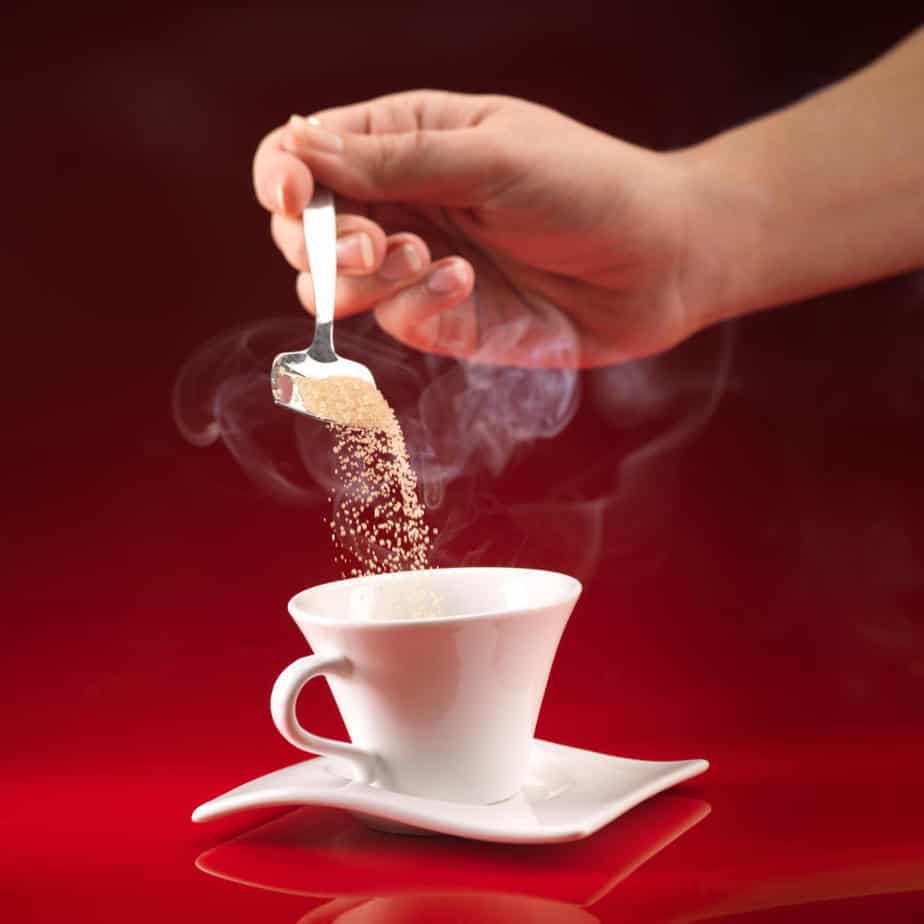With coffee being so popular, it didn’t take too long for avid coffee drinkers to devote themselves to various brews of coffee completely in this enthusiasm that has risen around coffee, specialty coffee filtered through as a particular interest of coffee enthusiasts.
However, everyone takes their coffee differently, and there are some things that, despite having the option of variations, should be done a specific way. In this case – anyone can add sugar to their coffee, but that doesn’t necessarily mean that the drinker will achieve the maximum out of the drink if they do.

So, what do the experts say about drinking specialty coffee with sugar?
Specialty coffee drinks would be sweet by design. 80 points or higher SCA grade coffee will have a level of sweetness different from Commercial grade coffee, which is usually bitter. Experts insist that you should take your coffee in any way you find it tasty, sweetness levels are very subjective.
In this article, we’ll be focusing on the advice of professionals – how should specialty coffee be taken.
Let’s get started!
How to Drink Specialty Coffee?
Specialty Coffee is a high-quality product, that differs from commercial coffee. How does it differ? First thing: taste and aroma.
But before addressing the coffee itself, why do we add sugar to commercial coffee? – Simple, commercial coffee is supposed to be strong, full-bodied, and bitter. By adding sugar, or milk, or any other element to it, what we are looking for is to reduce its bitterness and try to keep the best part of the drink.
Commercial coffee quality shall only have the following typical or classic coffee flavors:
- Cacao
- Nuts
- Raisin
On the other hand, specialty coffee quality could contain, on top of classic coffee flavors, such as:
- Fruits
- Citrus
- Caramel
- Sugar
- Apple
There is a complete document explaining all potential flavors for specialty coffee, it is called The Coffee Taster’s Flavor Wheel.
What Is Specialty Coffee?
Specialty coffee is, simply put, the term for the highest grade of coffee available, which is usually referring to the entire supply chain, using a single origin of coffee grains of the highest quality that contains flavors and aromas different than commercial coffee.
Specialty Coffee can be confirmed using a coffee quality grading scale by the Specialty Coffee Association. You would find more details on Specialty Coffee or Third Wave coffee in our previous article.
This coffee is usually grown in the ‘Bean Belt’, between the tropics of Cancer and Capricorn. This tropical climate is ensuring that the coffee beans are thriving – these areas include South and Central America, Asia, and Africa.
Africa is particularly well-known for quality specialty coffee, with Ethiopia and Kenya leading the race because of the mainly volcanic soil there.
The most expensive specialty coffee in the world is actually Panama Geisha coffee, which has been sold for over US$1,200 per pound.
Specialty coffee is rarely found across mainstream coffee shops in North America – it usually has to be bought and prepared at home, even though there are specific coffee shops that actually prepare specialty coffee. You could call them specialty coffee shops. They’re actually much more prevalent in Australia and New Zealand, where specialty coffee has become mainstream.
This has risen a lot, actually, in the United States – while there were only 2,850 specialty coffee shops in 1993, there were 29,300 in 2013. Europe, in comparison, is a huge coffee market, and it accounts for 30% of global consumption!
However, it’s predicted that Asia will soon take that mantle over and become the top place of consumption of specialty coffee.
Now, let’s take a look at specialty coffee preparation and consumption.
What makes specialty coffee special?
There are scales to grade coffee based on different criteria:
| Aroma |
| Flavor |
| Aftertaste |
| Acidity |
| Body |
| Balance |
| Uniformity |
| Clean Cup |
| Sweetness |
| Cuppers Points |
There are other scales, and most share sweetness as an evaluation criterion. If sweetness needs to be evaluated, and the coffee should be sweet without sugar, adding sugar is restricting the person from getting the original characters from the bean. This is why the “no sugar on specialty coffee” team has a lot of followers.
What I suggest is that you try the blend you’re having without sugar, and if you find that it’s too much, then add some. Keep in mind, though, that the experts insist that you’re not going to achieve the maximum potential of the drink if you add sugar to it and that you should definitely think about switching to another blend that’s better per your personal preference.
How to prepare my specialty coffee?
When you’re drinking specialty coffee, preparation is crucial – that’s why we’re going to discuss brewing.
When preparing specialty coffee, you’re going to need some gear to get started.
The first thing you’re going to need is a coffee maker. Based on our experience, we like to use a french press to collect the most flavors from our specialty coffee. Dwell time will affect the flavor, body, and bitterness of the coffee – and all of this will definitely have a massive effect on the outcome.
You’ll also need a grinder. There is a significant difference between grinders and the size of the ground coffee. You should use a medium-fine grind for Aeropress when using a 2 to 3 minutes method. If you are brewing using an espresso machine, you should do it with a fine grind.
Automatic grinds can produce uneven ground coffee, that is what we have learned during our tests with Sboly Conical Coffee grinder (get it on Amazon) vs Hario Coffee Grinder (get it on Amazon). We get more evenly ground coffee from the Hario.
A kettle is essentially the most critical part of your equipment. There are nowadays even electronic, programmable kettles that allow you to set a specific temperature. It’s important to get the water to a temperature of 204 Fahrenheit, not to 212 (96 degrees Celsius, not 100) – and it’s best to purchase a programmable kettle for this, but we use Barista Warrior Stainless Steel Pour Over Coffee & Tea Kettle with Thermometer (Also available on Amazon).
You’ll need a timer, but you can simply use the timer on your phone. Something that you need but don’t have on your phone, though, is a scale. You will need a very accurate scale to measure coffee grains, and it’s going to need to be precise up to a gram.
You’ll also need water and specialty coffee beans, obviously.
When we’re discussing coffee, we mainly divide them into two categories – Arabica and Robusta.
Arabica is a high-quality coffee bean, and it’s actually the most popular coffee out there. It’s likely that the coffee you’re drinking right now, as you’re reading this article, is Arabica. Arabica makes up 60% of the world’s coffee production.
There are often hints of chocolate, nuts, berries, caramel, and fruit with Arabica, and it makes for a smooth cup of specialty coffee – it’s also nowhere near as bitter as Robusta. The downside to Arabica is its price – these coffee beans are harder to grow, so they’re naturally more expensive.
When we’re talking about Robusta, it’s the perfect choice for someone who prefers a more robust cup of coffee – ideal for waking you up. Robusta makes up 30% of the world’s coffee supply, and the beans are often mixed into various coffee blends.
The caffeine in Robusta is much higher than caffeine in Arabica. The taste is described as woody and earthy, with low notes of acidity. Robusta is usually used for cheaper coffee brands because it’s not as tricky to grow as Arabica, and it’s less expensive.
Both of these have thousands of variations, so make sure to experiment to pinpoint what you like exactly.
The first thing you should do when you’re making your coffee has weighed the beans. The amount of beans you’ll use depends on the amount of water you’ll use and the ratio should be 1:15. If you’re making a simple coffee cup of 250 ml, then you should use 15 grams of coffee.
Take that coffee and put it in the grinder, after which you’ll grind the beans. It’s essential to know how to grind your coffee. If your grind is more coarse, then your coffee will have a lighter body – finer grinds, on the other hand, bring out the bitterness of the beverage. Experiment with your grinder to find that perfect grind.
Set the filter in the dripper, and heat the water to the desired temperature (96 degrees Celsius) using the kettle. Rinse the filter with water – this will ensure that the taste of paper isn’t present with the coffee. After that, you’ll fill the filter with the ground coffee and start the timer – it should take about three minutes for 225-250 ml of water to pour.
You’ll now start the pour-over and firstly pour some water taking care to thoroughly wet the grinds. You should use little water at first and leave it like that for 30 seconds – this is called the blooming period, and it’s what allows the coffee to really achieve its superb taste.
After that, you just have to complete the pour. Just pour the water into your dripper in 30-second intervals. Many different people have various techniques for pouring coffee, so you should definitely look up other ways it can be done. This is somewhat the standard procedure when it comes to specialty coffee.
After that, your coffee’s made, and you can enjoy it.
Now, to the question at hand – should specialty coffee be drunk without sugar?
The universal answer is – because we need to maintain our drink as original and pure as possible. It is recommended that no sugar is added to the coffee – specialty coffee has such exciting and intense tastes that it’d be a shame if you messed with that by adding sugar, but if you’re a person who likes their coffee sweetened, then who am I to stop you.
Coffee enthusiasts insist that specialty coffee isn’t the same thing as any coffee you can pick up at a shop, and you shouldn’t add sugar to it.
If we’re talking about Arabica, then understand that most of these blends have tastes and notes of hazelnut, chocolate, caramel, etc. – and you don’t really need a sweetener because you already have natural ingredients that make the coffee tasty and sweet, compared to commercial-grade coffee.
However, when it comes to Robusta, I completely understand why someone would want to add sugar. This coffee is more bitter than Arabica, and it’s a bit difficult on the taste buds. If you’re a lover of bitter coffee, then you’re in luck! However, if you’re a lover of tastier coffee, then you’re not going to be happy with Robusta, and it’s completely understandable that you’re going to want to add sugar.
Literature:
